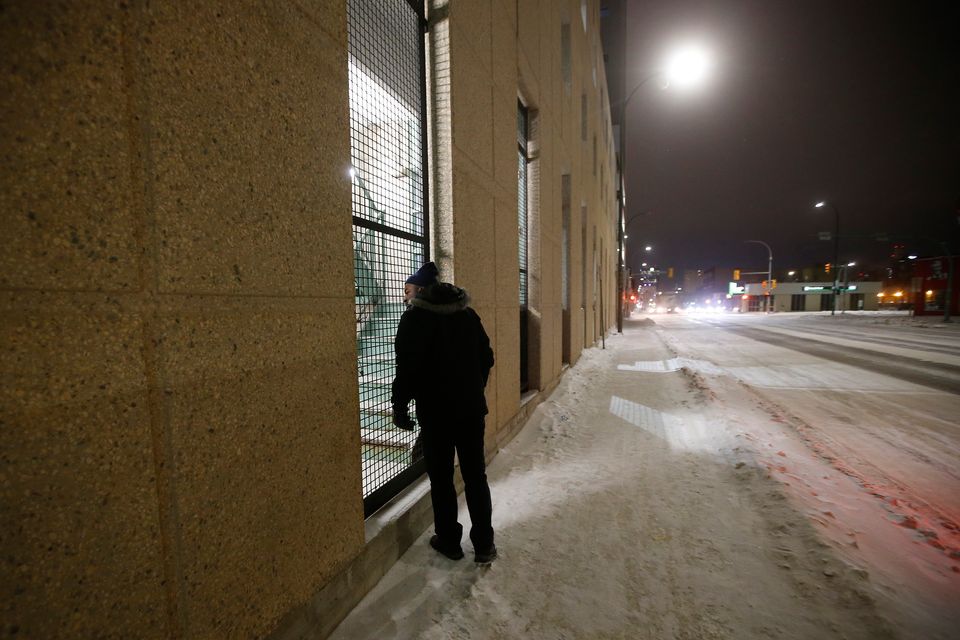[ad_1]
HuffPost/Rebecca Zisser
It was winter in Winnipeg when a 48-year-old man entered one of the city’s hospitals and complained of sharp chest pains and trouble breathing. He was admitted into intensive care and intubated. Still early 2020, the city wasn’t in a full pandemic lockdown just yet.
The man had already been seeking regular medical help for a year and half at that point in February. Chest pains and bouts of body lice infection, contracted during a stay at one of the city’s homeless shelters, made him a repeat patient in the emergency department.
Lice bites and scratches marked his body. When the sound waves of the ultrasound machine finished mapping an image of his damaged heart, doctors found the reason for the man’s shortness of breath and it wasn’t COVID-19: part of his mitral heart valve had dislodged and ended up in his lungs.
Carl Boodman/Canadian Medical Association Journal
The man, who can’t be identified because of patient confidentiality, was “quite unwell,” said Dr. Carl Boodman, a Winnipeg-based infectious disease expert who was called in after blood culture tests came back negative for common infections.
When he looked at the skin lesions that covered the man’s legs, Boodman told HuffPost Canada it immediately raised some “geeky” infectious diseases flags. The patient’s medical chart noted past intravenous drug use, which had led to an HIV diagnosis 14 years earlier. There was also a note that he was living in supportive housing and another about a stay in a homeless shelter the year before. More flags went up.
Get the top stories emailed every day. Newsletters may offer personalized content or advertisements.
Privacy Policy
Boodman wondered if the diagnosis could be Bartonella quintana, also known as trench fever. Like the name suggests, it’s a disease from another era. It gained notoriety during the First World War after more than a million troops were infected with it due to poor living conditions in Europe’s battlefield trenches. After the war, as personal hygiene improved and baths and washed clothes became part of regular life in many parts of the world, outbreaks of trench fever grew increasingly less common and eventually rare.
Courtesy of Carl Boodman
True to its name, Boodman said, people typically describe a fever that comes and goes every five days. Shin pain, headaches and rashes were common symptoms cited during the First World War. “But a lot of the patients I’ve seen, sometimes they complain of left upper quadrant pain. So it’s because their spleen is getting a little inflamed or big.”
In other cases, people are asymptomatic and their bloodwork comes back seemingly normal. That can be dangerous because if left untreated, trench fever can cause endocarditis — that’s when the heart’s inner lining becomes inflamed.
“It’s really a slow process,” Boodman explained. “There’s descriptions of it being in someone’s bloodstream for months and months on end, and people, you know, might be a little anemic or might feel a little, not great, but many people will not even notice it.”
Only four known Canadian cases have been reported in recent decades, according to a study published in the American Journal of Tropical Medicine and Hygiene. Outbreaks of the disease have been transmitted through body lice in refugee camps in East Africa and in homeless shelters in urban areas around the world where shared sleeping quarters are a common design.
***
Body lice and head lice are similar but not the same.
Body lice mostly live on clothing unlike head lice, which tend to stay on the scalp and in the hair. Body lice feed on skin cells a few times a day where they sometimes leave feces. That feces is an irritant, which causes people to itch and make abrasions in the skin. If that body lice feces is infected with the B. quintana bacterium that causes trench fever, those abrasions in the skin are the bacteria’s gateway into the bloodstream.
Some studies have shown 30-40 per cent of body lice can carry the B. quintana bacterium, Boodman said.
Though mature body lice can live up to 30 days, the feces of one infected with the B. quintana bacterium can remain “infectious for 12 months and new cases can arise for some time even after elimination of the louse population,” according to the European Centre for Disease Prevention and Control.
This explains why when the man’s blood test came back positive for trench fever, and despite the homeless shelter taking actions to improve its infection prevention and control measures, more positive cases followed.
CP/Mikaela MacKenzie
After that first positive diagnosis there were three more for different people all reported before the end of May. All men in Winnipeg between the ages of 33 and 62. For two of the men, the presenting symptoms were different: the infection caused a hemorrhage, bleeding in the brain. There was a common thread: everyone at one point either slept or ate meals at the same Winnipeg homeless shelter.
“This is a disease of extreme poverty,” said Leah Gazan, the NDP MP for the Winnipeg riding where the cluster of trench fever cases was reported. She made the remark during a hybrid sitting of the House of Commons in December. She called the situation “abhorrent,” one that had been made worse by inadequate funding.
“Our front-line organizations have the ability to address the needs of our community but often lack the resources to respond and provide care for individuals in need,” Gazan said. “We need help now.”
This is a disease of extreme poverty.NDP MP Leah Gazan
Boodman says trench fever belongs to a class of neglected diseases that are associated with poverty and under-housing today. “People don’t really think about how diseases have a disproportionate impact on people.”
The Winnipeg Regional Health Authority told HuffPost there was no information available for when they first became aware of the trench fever cases, which trace back to a city shelter. Spokesperson Paul Turenne said the health authority “has not undertaken any specific measures in response to these cases.”
Historial inequities and cycles of extreme poverty
Advocates have frequently made the connection between poverty and poor health outcomes, urging politicians at all levels of government to introduce policies and commit adequate funding to tackle interrelated issues of mental health and safe, affordable housing, which disproportionately impact lower income earners.
Some community-led programs have stepped up when politicians have delayed action. In lieu of a city-led approach, this model of poverty reduction, as described in a 2018 paper published by the Canadian Centre for Policy Alternatives, has been used in other cities such as Hamilton, Ont., where a special roundtable actively advocates for a living wage and municipal changes at city hall.
“Significant poverty reduction is achievable, but it will require all levels of government to work together and commit to comprehensive plans,” the paper states.
***
Approximately 77,000 Winnipeggers live in poverty, according to the Market Basket Measure in the most recent 2016 census. That number constitutes nearly 10 per cent of the city’s population. Two years later, the federal government announced that the Market Basket Measure (MBM) would serve as Canada’s official poverty line by region, which for a Winnipeg family would be a combined annual income of $44,030. The MBM is calculated using the market cost of a specific set of goods and services needed to have a “modest, basic standard of living,” according to Statistics Canada.
CP/Keith Levit
In Winnipeg, community programs help build bridges to engage and help residents in its inner city, where residents experience higher rates of poverty than in other areas. A 2011 report underlined the inequitable health implications of poverty in the city. It found those experiencing homelessness have significantly poorer health outcomes when compared to the general population, including being 20 times as likely to have hepatitis C, three times as likely to have a heart attack, and six times as likely to have angina — chest pain caused by reduced blood flow to the heart.
When the cluster of trench fever cases were reported last year, it set off alarm bells at all levels of government about the dire situations some people are facing with extreme poverty.
Boodman said part of the reason he found four cases in a span of months, despite very few incidents in the past 20 years, is because his interest in diseases of poverty and neglected diseases primed him to look for it in the first place. He hopes news of the Winnipeg cluster can serve as a reminder for people in the medical community to keep an open mind about things that might not be familiar from their personal experiences.
I think there [are] systemic reasons, just the way that you know there’s systemic racism, and certain diseases are studied and certain diseases get more funding than others — that also influences what is known and what is common knowledge and what isn’t.Dr. Carl Boodman, Winnipeg-based infectious diseases expert
“Some of it’s my own bias,” Boodman said, “I’ve been kind of wondering about this disease for quite some time and had read the literature and a lot of people didn’t really think it was there because it’s hard to diagnose.”
That’s partly because when you look at Bartonella quintana under a microscope, it’s hard to see. Its rod-like shape doesn’t take well to stains. Another reason is it’s not a common disease on the forefront of many medical experts’ minds. Rare diseases can often be initially missed. Boodman had to push lab technicians to look for evidence of trench fever when he ordered the blood test.
“I think there [are] systemic reasons, just the way that you know there’s systemic racism, and certain diseases are studied and certain diseases get more funding than others — that also influences what is known and what is common knowledge and what isn’t.”
Majority of people experiencing homelessness in Winnipeg are Indigenous
Income can be a factor in unmet health care needs.
A 2014 Statistics Canada survey found participants with lower incomes were more likely to have reported an unmet health care need than people earning middle or higher incomes.
For people experiencing homelessness and precarious housing, the situation can sometimes be dire. According to the New England Journal of Medicine, that exact demographic risks being caught at the “bottom of the health care rationing iceberg.” How can a patient heal if they have to return to a shelter or the streets?
Census data is one tool that’s used to help governments determine funding and resources. Until a few years ago, people experiencing homelessness who wanted to be included in the census had a phone line they could call to be counted. Shelters are now playing a bigger role, as well as grassroots community members, in ensuring some of society’s most vulnerable people are not further ostracized and condemned to repeating cycles of extreme poverty.
To get a better picture of the dynamic situation, volunteers have taken the initiative in some Canadian cities to count the number of people experiencing homelessness. In Winnipeg, hundreds of people have signed up on two occasions to conduct a street census to capture the city’s homelessness population “in a single moment of time” during one 24-hour period.
The last time volunteers conducted a street census was in 2018 when 1,519 people were surveyed among those experiencing homelessness at sites including emergency, domestic violence and youth shelters, community agencies, and transitional housing.
CP/John Woods
Volunteers recorded nearly 900 people who indicated they had provisional non-shelter accommodations such as someone else’s home, transitional housing, or institutional care. They found men accounted for more than 65 per cent of people experiencing homelessness on that mid-April census day. The average age of someone experiencing homelessness was 40. An overwhelming 66 per cent of the people counted were Indigenous.
These numbers were collected two years before the COVID-19 pandemic exacerbated pre-existing inequities in society. The street census is supposed to take place every two years, but like many events planned for 2020, it was postponed due to the pandemic.
In the meantime, Boodman, who is also studying medical microbiology at the University of Manitoba, said he’s continuing his mission to raise awareness about diseases that almost exclusively affect poor populations, which he said “for that reason, there’s less research, and less diagnostics and less therapeutics that are available.”
He still checks in with the man he first diagnosed with trench fever, whom Boodman said “ultimately had an infection that was a consequence of being under-housed.” The man got cardiovascular surgery to fix the damage done to his heart by the undetected condition, an accomplishment in itself because it’s a procedure often not available to people with a history of IV drug use.
“He survived, he was on dialysis for a little bit, he got off dialysis,” Boodman said, adding that the man’s HIV is well controlled, he’s gaining weight and doing well — and he has a new home.
“He walked two kilometres to come see me,” Boodman said. “He has friends, he interacts with his family. And, and, you know, it’s just great to see him. He’s happy.”
[ad_2]
Source link





